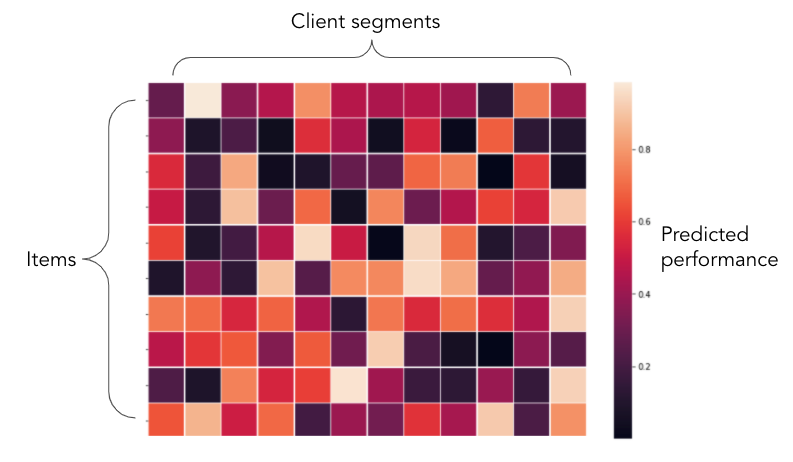
Last year, Stitch Fix made a commitment to stand in support of the Black, Indigenous and People of Color (BIPOC) community and denounced systemic racism, state-sanctioned violence, and white supremacy. It was important for us to not simply make a statement, but to put meaningful, focused, and sustained action behind our words. As a part of this call to action we saw an opportunity to use our influence and resources to drive more opportunity for BIPOC-owned businesses in the fashion industry. In order to accelerate change within our own vendor base, as well as in the larger industry, we founded the Stitch Fix Elevate Grant & Mentorship Program, with a mission of helping to grow, mentor, and support BIPOC-owned apparel and accessories companies.
True to Stitch Fix form, the Elevate Program was catalyzed by a sense of responsibility, enabled by innovation and partnership, and designed as a synergy between art and science. In this blog post, we describe the contributions of data science to the Elevate Program. We begin by describing in broad strokes our approach to algorithm-assisted inventory curation. For the Elevate Program, we selectively repurposed our inventory algorithms in order to build early product-market fit reports for full catalogs of outside merchandise. This has allowed us to rapidly onboard new vendors while expanding our inventory into foundationally different merchandise. Moreover, we are extending the use of these algorithms directly to vendors, in effect arming them with the same strategic advantages that drive our own data science investments. These efforts are designed to catalyze larger change across the retail landscape by disrupting the existing paths between talent and success.
Style Discovery
Stitch Fix’s inventory is carefully curated by expert merchandise buyers, and this curation is indispensable to our ability to offer personalization at scale. Inventory curation is a complex task, particularly in the face of a ~4-million person and rapidly-growing client base. It is also highly dynamic, driven by an evolution both in client tastes and in the greater fashion landscape.
In order to facilitate the inventory curation process, our Style Discovery algorithms team works closely with merchandise buyers. The specific approaches, architectures, and integrations the Style Discovery team uses will be the subject of upcoming blog posts. But broadly speaking, Style Discovery builds recommender systems that predict how successful a new item will be, if we decide to bring it into our inventory. These predictions are made in the aggregate and also for a range of client segments, enabling our buyers to drive both overall inventory success and increased penetration with specific client segments.
Importantly, these recommendation tools are meant to empower buyers and not to limit the considerable expertise they bring to bear. For that reason, Style Discovery’s recommendations neither restrict the items our buyers consider, nor the items they can ultimately purchase. Instead, our recommendations act as an additional piece of ‘decision context’ for any item under consideration. Buyers can then integrate this decision context with their own understanding of shifting market and trend forces, enabling them to use both intuition and algorithmic power to strategically build our inventory.
Style Discovery for Elevate
Last summer, on the backdrop of accelerating worldwide protest movements, we reevaluated our own priorities with a lens of responsibility. Through this lens, we worked to reframe our data science problem space in order to identify projects at the intersection of social impact and business value. Specifically, we asked how we could leverage our algorithms to support diversity in our vendor base, and how we could use those immediate efforts to catalyze larger, lasting change across the industry.
Having asked the question, it was an innovation that allowed us to act. We reasoned that if our Style Discovery algorithms could predict merchandise success, they could be repurposed to rapidly evaluate external merchandise portfolios. This would allow us to provide product-market fit reports to early-stage entrepreneurs, in effect turning our considerable power in data science into an investment in the success of these entrepreneurs. Taking this one step further, we could also reimagine the ways expert vendors are discovered and onboarded, in effect drawing a new line between talent, opportunity, and success.
Driven by these motivations, and in productive partnership with a multitude of teams across Stitch Fix, as well as an outside advisor, Harlem’s Fashion Row founder and CEO Brandice Daniel, we founded the Stitch Fix Elevate Grant & Mentorship Program to support and mentor BIPOC-owned companies. Each fall, the Elevate Program will open a call for early-stage BIPOC-owned apparel and accessories companies to submit an application and a merchandise portfolio. Each year, Stitch Fix will select a new cohort of Grantees. The first Grantees are currently participating in a program that provides support, amplification, and mentorship and will culminate in Stitch Fix placing wholesale orders for their merchandise. In effect this is aimed at giving their merchandise exposure to our enormous base of clients in the United States.

Machine Learning Integration
At Stitch Fix we believe that good data science requires not just an aptitude for algorithms per se, but also a strong philosophy for how our algorithmic insights can be effectively and ethically integrated. With this framework in mind, our Style Discovery algorithms were never used as a ‘filter’ to determine which vendors should or should not be supported through Elevate. Instead, Grantee selection was performed by a diverse committee of experts, and according to rigorous standards of objectivity and fairness.
In order to use our data science efforts to add value for early-stage vendors, we used Style Discovery algorithms to build product-market fit ‘reports’ for the merchandise portfolios submitted by each of the program’s finalists. These ‘Discovery Reports’ were then provided directly to our finalists; to ensure that the report’s findings and potential biases were clearly communicated, each finalist discussed their product-market fit report with data scientists and merchandise buyers. Importantly, we approached this as a development process. Early and frequent engagement with our finalists and Grantees has been fundamental to our ability to build actionable Discovery Reports.
Ultimately, for every item in an applicant’s portfolio, the Discovery Report provides success predictions, both in the aggregate and across all of our internal client segments. Moreover, by including Elevate merchandise on our Style Shuffle app, we were able to collect around 2 million user ratings for our finalists. This allowed us to measure the immediate emotional resonance of every item in each portfolio.
Each Discovery Report brings to bear Stitch Fix’s understanding of thousands of styles and millions of client interactions. But the reports are not simply abstract collections of data. We learned through our process of iteration and improvement that each Discovery Report tells a story. Some of those stories were about the groups of younger clients who loved a vendor’s designs but were not reached by the vendor’s existing sales model. Other stories were about the surprisingly expansive market for more authenticity and flair in professional settings. All of these stories shared a sense of discovery and of personalization. But just as importantly, we found that each story could directly inform a sales, development, and marketing strategy. In other words, the insights from Discovery Reports were not simply actionable; they were stories of a success that we could help these entrepreneurs to realize.

Empowering the Elevate Program’s Inaugural Cohort
In January, the Elevate Program selected six talented and inspiring inaugural Grantees. Each Grantee received a $25,000 grant to grow their business. But that grant is only the beginning. Over the course of eight months, Grantees received bespoke programs of mentorship and support, including one-on-one meetings with our founder Katrina Lake and one-on-one meetings with Brandice Daniel of Harlem’s Fashion Row. They also attended a series of training modules covering such topics as data-driven design, algorithms for merchandising, and growth marketing.
Finally, for the duration of the program, Grantees received support from our Algorithms group in the form of periodic Discovery Reports. Grantees discussed insights from these reports directly with data scientists, merchandise partners, and others. Providing these additional reports has several functions, all of which are meant to set our Grantees up for success. One important function is the continued development of the reports themselves; feedback from our Grantees about what is or isn’t useful, or about what they would like to see, will help us refine or pivot so that we can build reports that are as actionable as possible.
We also expect the Discovery Reports to be a part of the feedback cycle of growth and product development; in other words, the reports will become a cornerstone of AI-assisted design. As our Grantees expand or fine-tune their portfolios, the Discovery Reports will be updated with new predictions. These new predictions will bring into greater and greater focus the stories of success we aim to enable. We are honored and humbled to be a part of this process, and hope that our efforts to reframe our work with a lens of responsibility will inspire the data science community and spark sustained change across the industries we serve.
